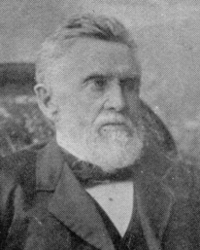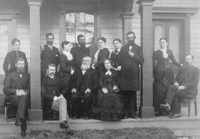John Hossack facts for kids
Quick facts for kids
John Hossack
|
|
|---|---|

John Hossack
|
|
| Born | December 6, 1806 Elgin, Moray, Scotland
|
| Died | December 8, 1891 (aged 85) Ottawa, Illinois, United States
|
| Nationality | Scottish-American |
| Occupation | Grain and lumber trader, abolitionist |
| Known for | Involvement in the Underground Railroad |
| Movement | Slavery abolition |
| Criminal charge(s) | Violating the Fugitive Slave Law of 1850 |
| Criminal penalty | Ten days imprisonment, $100 fine |
| Spouse(s) | Martha Lens (1833–?) |
| Children | Eleven children |
John Hossack (born December 6, 1806 – died November 8, 1891) was a Scottish-American man who fought against slavery. He was known as an abolitionist. His home, the John Hossack House, was a safe place on the Underground Railroad. This was a secret network that helped enslaved people escape to freedom. John Hossack became famous in 1860. He was put on trial and found guilty of breaking the Fugitive Slave Law of 1850. This happened because he helped an African American man named Jim Gray escape from people who wanted to capture him and force him back into slavery.
Contents
John Hossack's Early Life (1806-1838)
John Hossack was born in 1806 in Elgin, Scotland. When he was twelve, he moved to North America. He went to Quebec to work in his uncle's candy store. As an adult, he started his own candy business.
In 1833, he married Martha Lens. They had eleven children together. Soon after his marriage, John Hossack changed careers. He became a contractor for building a canal on the Saint Lawrence River. This canal was called the Long Sault canal.
Fighting Against Slavery (1838-1859)
In 1838, John Hossack moved to Chicago. He worked as a contractor on the Illinois and Michigan Canal. However, the money for the canal ran out. John Hossack had invested all his money in the project. He had to find new work. He started a farm called "Hossack's Grove" in Cook County.
It was during this time that he first joined the fight against slavery. Hossack's Grove became a safe place for people who had escaped slavery.
In 1849, Hossack moved to Ottawa, Illinois. He started working in the lumber business. He also began buying and shipping grain to Chicago. Within a few years, he was one of the biggest lumber and grain dealers in the Midwestern United States.
As an important citizen in Ottawa, Hossack helped build a bridge over the Illinois River. In 1854, he built the John Hossack House near the river. During this time, he became even more involved with the Underground Railroad. Sometimes, as many as thirteen fugitive slaves stayed at his house at once.
Hossack openly spoke out against the Fugitive Slave Law of 1850. He called it "infamous" and against God's laws. He became friends with other important abolitionists. These included William Lloyd Garrison, Owen Lovejoy, and Gerrit Smith.
John Hossack was also present at the first of the famous Lincoln-Douglas debates. This important debate happened in Ottawa in August 1858.
The Jim Gray Story (1859-1860)
In 1859, three enslaved people escaped from a plantation in New Madrid County, Missouri. One of them was Jim Gray. On September 4, 1859, Jim Gray was captured by people who hunted down escaped slaves in Union County, Illinois. He was put in jail.
An abolitionist named Benajah G. Roots noticed the slave catchers. He demanded that Gray be taken before a judge. The judge did not let the slave catchers take Gray back to Missouri. But he also would not release Gray because he didn't have "freedom papers."
So, Roots asked John D. Caton, a top judge in Illinois, for help. Judge Caton was in Ottawa, Illinois. He agreed that the state law holding Gray was unfair. However, he ordered the sheriff to send Gray to a federal official in Springfield, Illinois. This was so the federal government could decide what to do under the Fugitive Slave Law of 1850.
Many abolitionists, including John Hossack, were in court that day. When they heard the judge's decision, they shouted for Gray to run. Hossack yelled, "If you want your liberty, come!" Other abolitionists blocked the way of the law officers. Hossack quickly led Gray into a waiting carriage. Jim Gray escaped to Chicago and eventually reached Canada, where he found freedom.
Because he helped Jim Gray, John Hossack was accused of breaking the Fugitive Slave Law. He was tried in Chicago before Judge Thomas Drummond. The jury found Hossack guilty. But they asked the judge to be kind to him. Judge Drummond sentenced Hossack to ten days in jail and a $100 fine.
Before his sentencing, Hossack gave a powerful speech to the court. This speech was later published by the American Anti-Slavery Society. He said, "I am found guilty of a violation of the Fugitive Slave law, and it may appear strange to your honor that I have no sense of guilt." He also said that he was "guilty of carrying out the still greater principles of the Declaration of Independence." He believed he was doing what was right. He ended by saying, "I am guilty of no crime. I therefore ask for no mercy; I ask for justice."
During his ten days in prison, John Hossack was treated like a hero. The mayor of Chicago, John Wentworth, even held a banquet for him. People greatly admired him.
Later Life (1860-1891)
During the American Civil War, John Hossack was very active. He helped with the Soldiers' Aid Societies. These groups supported soldiers and their families.
In 1873, Hossack became completely blind. Because of this, he retired from his lumber and grain businesses. He passed away in Ottawa in 1891.


